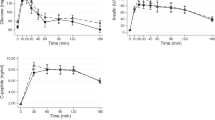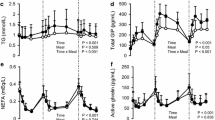Abstract
The increase in insulin requirement at the onset of adolescence is compensated by an increase of insulin secretion. This metabolic pattern persists during adolescence but is no longer present in adults. It is supposed to depend on a decrease of insulin sensitivity of uncertain origin. We compared the metabolic pattern of late adolescent girls (13–16 year old) with young women (21–30 year old) with similar body mass indexes, testing subjects with iv glucose tolerance test (IVGTT) (glucose 0.33 g/kg) and arginine test (ATT) (arginine 30 g in 30 min). In late adolescent vs adult women we observed: i) IVTT: similar k of glucose tolerance and higher insulin and C-peptide responses; ii) ATT: unmodified plasma glucose, insulin and glucagon values, higher GH plasma levels; iii) in adolescent girls GH and CPR incremental areas significantly correlated (r = 0.755, p < 0.05). These data show that: i) the adolescent pattern of glucose metabolism persists after completion of sexual development and, ii) there is a positive correlation between GH response to arginine and beta-cell response to glucose. So GH should play a role in the impairment of glucose metabolism during adolescence.
Similar content being viewed by others
References
Mann N.P., Johnston D.I. Improvement in metabolic control in diabetic adolescents by the use of increased insulin dose. Diabetes Care 7: 460, 1984.
Rosenbloom A.L., Wheeler L., Bianchi R., Chin F.T., Finegold D. Age-adjusted analysis of insulin responses during normal and abnormal glucose tolerance tests in children and adolescents. Diabetes 24: 820, 1975.
Amiel S.A., Sherwin R.S., Simonson D.C., Lauritano A.A., Tamborlane W.V. Impaired insulin action in puberty. A contributing factor to poor glycemic control in adolescents with diabetes. N. Engl. J. Med. 315: 215, 1986.
Tanner J.M. Growth and Adolescence, 2nd ed. Blackwell, Oxford, 1962.
Heald F.P., Jacobson M.S.: Nutrition of the school child and adolescent. In: McLaren D.S., Burnman D. (Eds.), Texbook of pediatric nutrition, 2nd ed. Churchill Livingstone, New York, 1982, p. 74.
Josefsberg Z., Vilunski E., Hanukuglu A., Bialik O., Brown M., Karp M., Laron Z. Glucose and insulin responses to an oral glucose load in normal children and adolescents. Isr. J. Med. Sci. 12: 189, 1976.
Soeldner J.S. The intravenous glucose tolerance test. In: Fajans S.S and Sussman K.E. (Eds.). Diabetes Mellitus: Diagnosis and Treatment, vol. III. American Diabetes Association, New York, 1971.
Palmer J.P., Walter R.M., Ensinck J.W. Arginine-stimulated acute phase of insulin and glucagon secretion. I. In normal man. Diabetes 24: 735, 1975.
Hales C.N., Randle P.J.: Immunoassay of insulin with insulin antibody precipitate. Biochem. J. 88: 137, 1971.
Kaneko T., Oka H., Munemura T., Oda T., Yamashita K., Suzuki S., Yanaihara N., Hashimoto T., Yanaihara C. Radioimmunoassay of human proinsulin C-peptide using syntetic human connecting peptide. Endocrinol. Jpn. 21: 141, 1974.
Henquin J.C., Malvaux P., Lambert A.E. Glucagon immunoassay using polyethylene glycol to precipitate antibody bound hormone. Diabetologia 10: 61, 1974.
Schalch H.S., Parker M.L. A sensitive double antibody immunoassay for human growth hormone in plasma. Nature 203: 1141, 1964.
Conard V., Franckson J.R.M., Bastenie P. Intérêt d’une mésure clinique de l’assimilation glucidique. Sem. Hop. Paris 29: 2444, 1953.
Bloch C.A., Demons P., Sperling M.A. Puberty decreases insulin sensitivity. J. Pediatr. 110: 481, 1987.
Marshall W.A., Tanner J.M. Variations in pattern of pubertal changes in girls Arch. Dis. Child. 44: 291, 1969.
Smith C.P., Archibald H.R., Thomas J.M., Tarn A.C., Williams A.J.K., Gale E.A.M., Savage M.O. Basal and stimulated insulin levels rise with advancing puberty. Clin. Endocrinol. (Oxf.) 28: 7, 1988.
Kahn R.C. Insulin resistance, insulin insensitivity and insulin unresponsiveness: a necessary distinction. Metabolism 27: 1893, 1978.
Kolterman O., Insel J., Sackow M., Olefsky J.M. Mechanisms of insulin resistance in human obesity. J. Clin. Invest. 65: 1272, 1980.
Ducharne J.R., Forest M.G., De Peretti E. Plasma adrenal and gonadal sex steroids in human pubertal developement. J. Clin. Endocrinol. Metab. 42: 468, 1976.
Luft R., Cerasi E. Human growth hormone as a regulator of blood glucose concentration and as a diabetogenic substance. Diabetologia 4: 1, 1968.
Bratusch-Marrain P.R., Smith D., DeFronzo R.A. The effect of growth hormone on glucose metabolism and insulin secretion in man. J. Clin. Endocrinol. Metab. 55: 973, 1982.
Frisch R.E., Revelle R., Cook S. Components of the critical weight at menarche and at initiation of the adolescent spurt: estimated total water, lean body mass, and fat. Hum. Biol. 45: 469, 1973.
Yki-Jarvinen H. Insulin sensitivity during menstrual cycle. J. Clin. Endocrinol. Metab. 59: 350, 1984.
Nestler J.E., Barlascini C.O., Clore J.N., Blackard G. Dehydroepiandrosterone reduces serum low density lipoprotein levels and body fat but does not alter insulin sensitivity in normal man. J. Clin. Endocrinol. Metab. 66: 57, 1988.
Vermeulen A. Les Androgènes. Masson, Paris, 1979, pp. 1–20.
Press M., Tamborlane W.W., Sherwin R.S. Importance of raised growth hormone levels in mediating the metabolic derangement of diabetes. N. Engl. J. Med. 310: 810, 1984.
Rizza R.A., Mandarino L.J., Gerich J.E. Effects of growth hormone on insulin action in man. Diabetes 31: 663, 1982.
Miller J.D., Tannenbaum G.S., Colle E., Guyda H.J. Daytime pulsatile growth hormone secretion during childhood and adolescence. J. Clin. Endocrinol. Metab. 59: 350, 1982.
Zadik Z., Chalew S.A., McCarter R.J., Jr. Meistas M., Kowarski A.A. The influence of age on the 24-hour integrated concentration of growth hormone in normal individuals. J. Clin. Endocrinol. Metab. 60: 513, 1985.
Author information
Authors and Affiliations
Rights and permissions
About this article
Cite this article
Benassi, L., Tridenti, G., Orlandi, N. et al. Glucose tolerance and insulin release in adolescent female. J Endocrinol Invest 14, 751–756 (1991). https://doi.org/10.1007/BF03347909
Received:
Accepted:
Published:
Issue Date:
DOI: https://doi.org/10.1007/BF03347909




